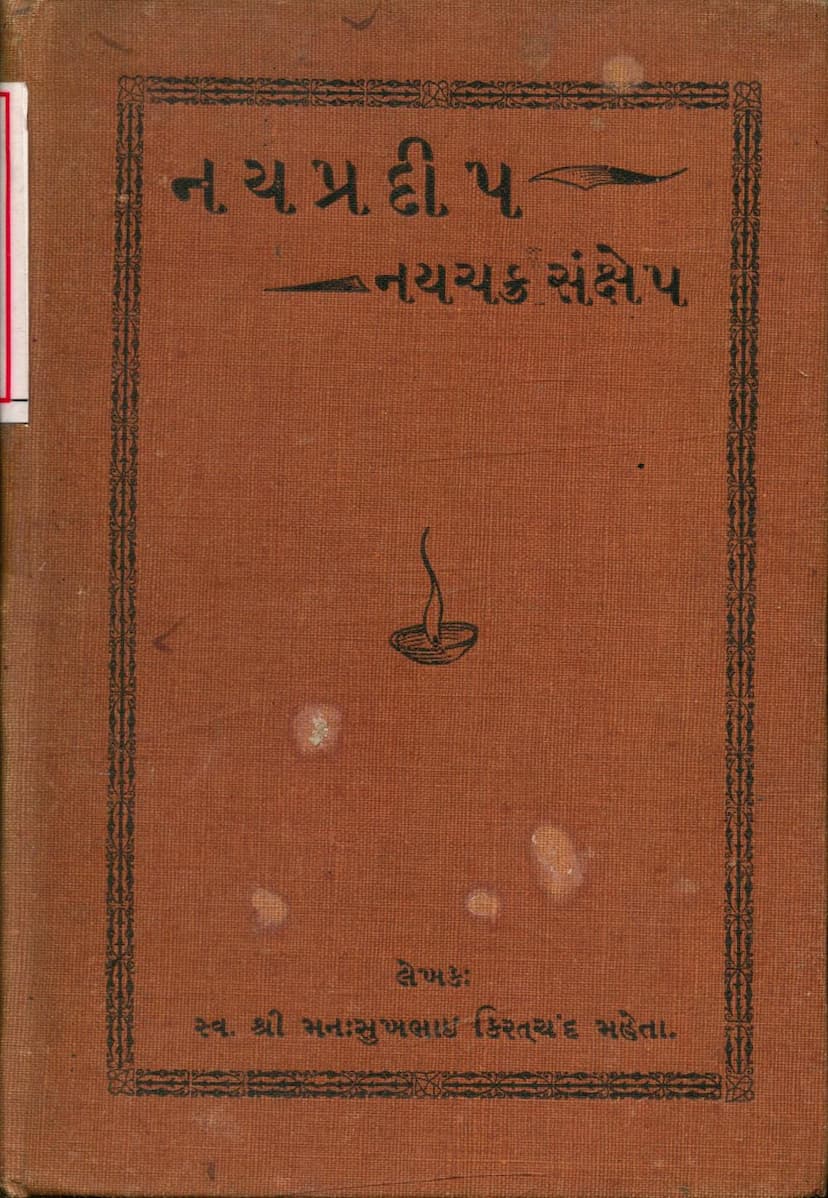Naypradip Naychakra Sankshesp
Added to library: September 2, 2025

Summary
This document is a scholarly work titled "Naypradip Naychakra Sankshesp" (નયપ્રદીપ નયચક્ર સંક્ષેપ), authored by the late Shri Mansukhbhai Kiratchand Mehta. The publisher is Bhagwandas Mansukhbhai Mehta. The book is described as an annotated translation and critique of "Nay Pradip" by Shriman Yashovijaygani and "Nayachakra Sankshep Swarup."
Here's a comprehensive summary based on the provided pages:
Core Subject Matter:
The book delves deeply into the Nayas (नय) in Jain philosophy. Nayas are considered different viewpoints or perspectives through which reality can be understood. The text aims to clarify the intricate and often complex nature of these philosophical tools, making them accessible to the reader.
Key Components and Themes:
-
The Role of Nayas: The central theme is the explanation and elucidation of various Nayas, which are crucial for understanding the multifaceted nature of Jain philosophy. The text emphasizes that relying on a single Naya leads to incomplete or erroneous understanding (ekantavada), whereas the proper application of multiple Nayas reveals the true nature of reality.
-
"Nay Pradip" by Yashovijaygani: This section focuses on Yashovijaygani's work, which is described as a "lamp" illuminating the correct scriptural form of Nayas. Mansukhbhai Mehta's contribution is a detailed commentary and extensive annotations, making a difficult subject clear and shedding significant light on the path of Nayas. Yashovijaygani is presented as an expert and authority on Nayas, having authored numerous works on the subject.
-
"Nayachakra Sankshep Swarup": This is another essay by Mansukhbhai Mehta, which is said to reinforce the concepts presented in "Nay Pradip." It covers similar topics, offering a concise overview.
-
"Bhinna Bhinna Granthanusar Sapt Nay Vyakhyā": The third part of the book presents definitions and explanations of the seven main Nayas (Naiigama, Sangraha, Vyavahāra, Rjusūtra, Shabda, Samabhiruḍha, and Evaṃbhūta) as found in various Jain scriptures. This comparative approach is intended to aid students and researchers in understanding the nuances.
-
Saptabhangi (Seven-Valued Predication): A significant portion of the text is dedicated to explaining the Saptabhangi, a foundational concept in Jain logic. It is described as the basis of Jain reasoning and a method to overcome the arguments of opponents. The book elaborates on the seven forms of Saptabhangi, explaining their structure, meaning, and the role of qualifiers like "syāt" (perhaps/in some way) and "eva" (indeed/only). The emphasis is on understanding the relative and conditional nature of statements about reality.
-
Dravya, Guna, Paryaya, and Swabhava: The text extensively discusses the Jain concepts of:
- Dravya (Substance): Defined as that which possesses existence, has characteristics, and undergoes modification. It is elaborated with ten general qualities and sixteen specific qualities.
- Guna (Quality): Described as inherent attributes of a substance.
- Paryaya (Mode/Modification): Defined as the changing states or manifestations of a substance. The text differentiates between Swabhava (natural) and Vibhava (unnatural/accidental) Paryayas.
- Swabhava (Inherent Nature): The intrinsic nature of a substance, with eleven general and ten specific manifestations discussed.
-
The Two Main Nayas: Dravyārthika and Paryāyārthika:
- Dravyārthika Naya: Focuses on the substantial aspect of reality, the underlying substance that remains constant through changes. It is further divided into several sub-categories (Naiigama, Sangraha, Vyavahāra).
- Paryāyārthika Naya: Focuses on the modal or qualitative aspect, the changing states and attributes. It is divided into Rjusūtra, Shabda, Samabhiruḍha, and Evaṃbhūta.
-
Nuances of Naya Classification: The book explores different ways of categorizing Nayas (e.g., as Artha Naya vs. Shabda Naya) and explains their hierarchical relationship in terms of scope (from broad to subtle).
-
Critique of "Kūnaya" or "Nayābhāsa" (Fallacious Nayas): The text also identifies and explains fallacious perspectives (Nayābhāsa) that arise from misinterpreting or misapplying Nayas, leading to one-sided or erroneous conclusions (ekāntavāda). Various philosophical schools like Nyayika, Vaisheshika, Buddhist, Charvaka, and Advaita Vedanta are referenced in this context.
-
Practical Application and Synthesis: The book highlights that Nayas are not mere academic debates but practical tools for understanding reality and achieving liberation (Parmārtha). It includes illustrative examples of how Nayas can be applied to the soul (Atman) and in devotion to the divine (Prabhubhaktī).
-
Scholarly Approach: The author, Mansukhbhai Mehta, is praised for his in-depth study, meticulous research, and ability to present complex philosophical concepts in a lucid and accessible manner. The inclusion of extensive footnotes and comparative analysis from various texts demonstrates the scholarly rigor of the work.
Overall Objective:
The primary goal of "Naypradip Naychakra Sankshesp" is to provide a comprehensive and clear exposition of the Naya doctrine in Jainism, enabling readers to grasp the nuanced philosophical framework that allows for a holistic understanding of reality, avoiding rigid and incomplete perspectives. It serves as an invaluable resource for students and scholars of Jain philosophy.